Nanostrip-Induced High Tunability Multipolar Fano Resonances in a Au Ring-Strip Nanosystem
Abstract
1. Introduction
2. Theoretical Methods
3. Results and Discussion
4. Conclusions
Author Contributions
Funding
Acknowledgments
Conflicts of Interest
References
- Barnes, W.L.; Dereux, A.; Ebbesen, T.W. Surface plasmon sub-wavelength optics. Nature 2003, 424, 824–830. [Google Scholar] [CrossRef] [PubMed]
- Chen, J.J.; Zeng, Y.; Xu, X.B.; Chen, X.F.; Zhou, Z.G.; Shi, P.C.; Yi, Z.; Ye, X.; Xiao, S.Y.; Yi, Y.G. Plasmonic Absorption Enhancement in Elliptical Graphene Arrays. Nanomaterials 2018, 8, 175. [Google Scholar] [CrossRef] [PubMed]
- Hu, S.; Yang, H.L.; Han, S.; Huang, X.; Xiao, B.X. Tailoring dual-band electromagnetically induced transparency in planar metamaterials. J. Appl. Phys. 2015, 117, 043107. [Google Scholar] [CrossRef]
- Zhukov, A.V.; Bouffanais, R.; Konobeeva, N.N.; Belonenko, M.B. Two-dimensional electroacoustic waves in silicene. Appl. Phys. B 2018, 124, 10. [Google Scholar] [CrossRef]
- Liu, L.; Chen, J.J.; Zhou, Z.G.; Yi, Z.; Ye, X. Tunable absorption enhancement in electric split-ring resonators-shaped graphene array. Mater. Res. Express 2018, 5, 045802. [Google Scholar] [CrossRef]
- Zhang, S.P.; Wei, H.; Bao, K.; Hakanson, U.; Halas, N.J.; Nordlander, P.; Xu, H.X. Chiral surface plasmon polaritons on metallic nanowires. Phys. Rev. Lett. 2011, 107, 096801. [Google Scholar] [CrossRef] [PubMed]
- Anker, J.N.; Hall, W.P.; Lyandres, O.; Shan, N.C.; Zhao, J.; Van-Duyne, R.P. Biosensing with plasmonic nanosensors. Nat. Mater. 2008, 7, 442–453. [Google Scholar] [CrossRef] [PubMed]
- Tan, T.X.; Tian, C.G.; Ren, Z.Y.; Yang, J.; Chen, Y.J.; Sun, L.; Li, Z.T.; Wu, A.P.; Yin, J.; Fu, H.G. LSPR-dependent SERS performance of silver nanoplates with highly stable and broad tunable LSPRs prepared through an improved seed-mediated strategy. Phys. Chem. Chem. Phys. 2013, 15, 21034–21042. [Google Scholar] [CrossRef] [PubMed]
- Liu, J.Q.; Wang, L.L.; He, M.D.; Huang, W.Q.; Wang, D.; Zou, B.S.; Wen, S.C. A wide bandgap plasmonic Bragg reflector. Opt. Express 2008, 16, 4888–4894. [Google Scholar] [CrossRef] [PubMed]
- Liu, W.; Zhang, J.; Zhu, Z.; Yuan, X.; Qin, S. Electrically Tunable Absorption Enhancement with Spectral and Polarization Selectivity through Graphene Plasmonic Light Trapping. Nanomaterials 2016, 6, 155. [Google Scholar] [CrossRef] [PubMed]
- Cen, C.L.; Chen, J.J.; Liang, C.P.; Huang, J.; Chen, X.F.; Tang, Y.J.; Yi, Z.; Xu, X.B.; Yi, Y.G.; Xiao, S.Y. Plasmonic absorption characteristics based on dumbbell-shaped graphene metamaterial arrays. Phys. E 2018, 103, 93–98. [Google Scholar] [CrossRef]
- Ren, J.; Wang, G.; Qiu, W.; Lin, Z.; Chen, H.; Qiu, P.; Wang, J.-X.; Kan, Q.; Pan, J.-Q. Optimization of the Fano Resonance Lineshape Based on Graphene Plasmonic Hexamer in Mid-Infrared Frequencies. Nanomaterials 2017, 7, 238. [Google Scholar] [CrossRef] [PubMed]
- Liao, J.; Wu, X.; Liu, L.Y.; Xu, L. Fano resonance and improved sensing performance in a spectral-simplified optofluidic micro-bubble resonator by introducing selective modal losses. Opt. Express 2016, 24, 8574–8580. [Google Scholar] [CrossRef] [PubMed]
- Wang, Y.F.; Liao, L.M.; Hu, T.; Luo, S.; Wu, L.; Wang, J.; Zhang, Z.; Xie, W.; Sun, L.X.; Kavokin, A.V.; et al. Exciton-Polariton Fano Resonance Driven by Second Harmonic Generation. Phys. Rev. Lett. 2017, 118, 063602. [Google Scholar] [CrossRef] [PubMed]
- Lee, B.; Park, J.; Han, G.H.; Ee, H.S.; Naylor, C.H.; Liu, W.J.; Johnson, A.T.C.; Agarwal, R. Fano Resonance and Spectrally Modified Photoluminescence Enhancement in Monolayer MoS2 Integrated with Plasmonic Nanoantenna Array. Nano Lett. 2015, 15, 3646–3653. [Google Scholar] [CrossRef] [PubMed]
- Black, L.J.; Wiecha, P.R.; Wang, Y.; de Groot, C.H.; Paillard, V.; Girard, C.; Arbouet, A. Tailoring Second-Harmonic Generation in Single L-Shaped Plasmonic Nanoantennas from the Capacitive to Conductive Coupling Regime. ACS Photonics 2015, 2, 1592–1601. [Google Scholar] [CrossRef]
- Chen, J.; Xu, R.Q.; Mao, P.; Zhang, Y.T.; Liu, Y.J.; Tang, C.J.; Liu, J.Q. Realization of Fanolike resonance due to diffraction coupling of localized surface plasmon resonances in embedded nanoantenna arrays. Pasmonics 2015, 10, 341–346. [Google Scholar] [CrossRef]
- Liu, Z.; Liu, G.; Fu, G.; Liu, X.; Wang, Y. Multi-band light perfect absorption by a metal layer-coupled dielectric metamaterial. Opt. Express 2016, 24, 5020–5025. [Google Scholar] [CrossRef] [PubMed]
- Yi, Z.; Niu, G.; Ye, X.; Luo, J.S.; Li, X.B.; Jiang, X.D.; Huang, J.; Yi, Y.; Duan, T.; Zhang, J.C.; et al. Nanodisk-Induced Modification of Plasmon Coupling andAppearance of Fano Resonance Without Symmetry Breaking in Concentric Ag Nanoring-Nanodisk. Plasmonics 2017, 12, 889–898. [Google Scholar] [CrossRef]
- Rahmani, M.; Lei, D.Y.; Giannini, V.; Lukiyanchuk, B.; Ranjbar, M.; Liew, T.Y.F.; Hong, M.; Maier, S.A. Subgroup Decomposition of Plasmonic Resonances in Hybrid Oligomers: Modeling the Resonance Lineshape. Nano Lett. 2012, 12, 2101–2106. [Google Scholar] [CrossRef] [PubMed]
- Zhan, Y.; Lei, D.Y.; Li, X.; Maier, S.A. Plasmonic FanonResonances in Nanohole Quadrumers for Ultra-Sensitive Refractive Index Sensing. Nanoscale 2014, 6, 4705–4715. [Google Scholar] [CrossRef] [PubMed]
- Chen, Y.; Chu, J.R.; Xu, X.F. Plasmonic Multibowtie Aperture Antenna with Fano Resonance for Nanoscale Spectral Sorting. ACS Photonics 2016, 3, 1689–1697. [Google Scholar] [CrossRef]
- Liu, Z.; Liu, X.; Huang, S.; Pan, P.; Chen, J.; Liu, G.; Gu, G. Automatically acquired broadband plasmonic-metamaterial black absorber during the metallic film-formation. ACS Appl. Mater. Interfaces 2015, 7, 4962–4968. [Google Scholar] [CrossRef] [PubMed]
- Muhammad, N.; Khan, A.D.; Deng, Z.-L.; Khan, K.; Yadav, A.; Liu, Q.; Ouyang, Z. Plasmonic Spectral Splitting in Ring/Rod Metasurface. Nanomaterials 2017, 7, 397. [Google Scholar] [CrossRef] [PubMed]
- Limonov, M.F.; Rybin, M.V.; Poddubny, A.N.; Kivshar, Y.S. Fano resonances in photonics. Nat. Photonics 2017, 11, 543–554. [Google Scholar] [CrossRef]
- Chen, J.; Fan, W.F.; Zhang, T.; Tang, C.J.; Chen, X.Y.; Wu, J.J.; Li, D.Y.; Ying, Y. Engineering the magnetic plasmon resonances of metamaterials for high-quality sensing. Opt Express 2017, 25, 3675–3681. [Google Scholar] [CrossRef] [PubMed]
- Cen, C.L.; Lin, H.; Liang, C.P.; Huang, J.; Chen, X.F.; Yi, Z.; Tang, Y.J.; Duan, T.; Xu, X.B.; Xiao, S.Y.; et al. Tunable plasmonic resonance absorption characteries-tics in periodic H-shaped graphene arrays. Superlattices Microstruct. 2018, 120, 427–435. [Google Scholar] [CrossRef]
- Yang, D.J.; Yang, Z.J.; Li, Y.Y.; Zhou, L.; Hao, Z.H.; Wang, Q.Q. Tunable Fano Resonance in Rod-Ring Plasmonic Nanocavities. Plasmonics 2015, 10, 263–269. [Google Scholar] [CrossRef]
- Chen, Y.; Chen, Y.H.; Chu, J.; Xu, X.F. Bridged Bowtie Aperture Antenna for Producing an Electromagnetic Hot Spot. ACS Photonics 2017, 4, 567–575. [Google Scholar] [CrossRef]
- Lin, J.Y.; Tsai, C.Y.; Lin, P.T.; Hsu, T.E.; Hsiao, C.F.; Lee, P.T. Optical Properties of Plasmonic Mirror-Image Nanoepsilon. Nanoscale Res. Lett. 2016, 11, 327. [Google Scholar] [CrossRef] [PubMed]
- Johnson, P.B.; Christy, R.W. Optical constants of the noble metals. Phys. Rev. B 1972, 6, 4370. [Google Scholar] [CrossRef]
- Palik, E.D. Handbook of Optical Constants of Solids; Academic Press: San Diego, CA, USA, 1985. [Google Scholar]
- Koya, A.N.; Ji, B.; Hao, Z.; Lin, J. Resonance hybridization and near field properties of strongly coupled plasmonic ring dimer-rod nanosystem. J. Appl. Phys. 2015, 118, 113101. [Google Scholar] [CrossRef]
- Aizpurua, J.; Hanarp, P.; Sutherland, D.S.; Kall, M.; Bryant, G.W.; Garcíade-Abajo, F.J. Optical properties of gold nanorings. Phys. Rev. Lett. 2003, 90, 057401. [Google Scholar] [CrossRef] [PubMed]
- Link, S.; Mohamed, M.B.; El-Sayed, M.A. Simulation of the Optical Absorption Spectra of Gold Nanorods as a Function of Their Aspect Ratio and the Effect of the Medium Dielectric Constant. J. Phys. Chem. B 1999, 103, 3073–3077. [Google Scholar] [CrossRef]
- Becker, J.; Andreas, T.; Jakab, A.; Hohenester, U.; Sönnichsen, C. The Optimal Aspect Ratio of Gold Nanorods for Plasmonic Bio-sensing. Plasmonics 2010, 5, 161–167. [Google Scholar] [CrossRef]
- Yi, Z.; Niu, G.; Chen, J.F.; Luo, J.S.; Liu, X.N.; Yi, Y.; Duan, T.; Kang, X.L.; Ye, X.; Wu, P.H.; et al. Dipole, Quadrupole, and Octupole Plasmon Resonance Modes in Ag Nanoring Structure: Local Field Enhancement in the Visible and Near Infrared Regions. Plasmonics 2016, 11, 37–44. [Google Scholar] [CrossRef]
- Xiao, S.Y.; Wang, T.; Liu, T.T.; Yan, X.C.; Li, Z.; Xu, C. Active modulation of electromagnetically induced transparency analogue in terahertz hybrid metal-graphene metamaterials. Carbon 2018, 126, 271–278. [Google Scholar] [CrossRef]
- Chen, J.; Yi, Z.; Xiao, S.; Xu, X. Absorption enhancement in double-layer cross-shaped graphene arrays. Mater. Res. Express 2018, 5, 015605. [Google Scholar] [CrossRef]
- Yang, Z.J.; Hao, Z.H.; Lin, H.Q.; Wang, Q.Q. Plasmonic Fano resonances in metallic nanorod complexes. Nanoscale 2014, 6, 4985–4997. [Google Scholar] [CrossRef] [PubMed]

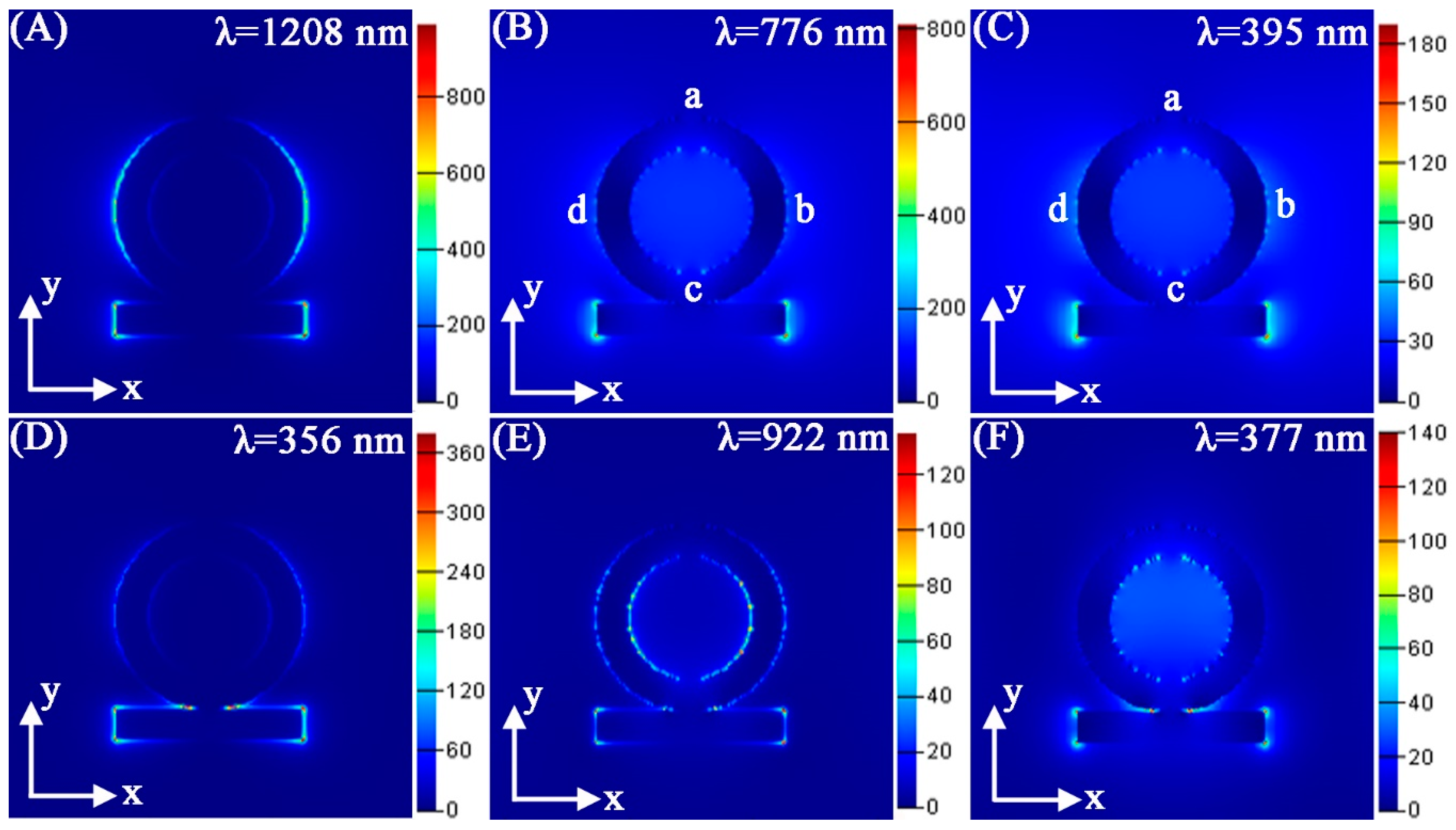
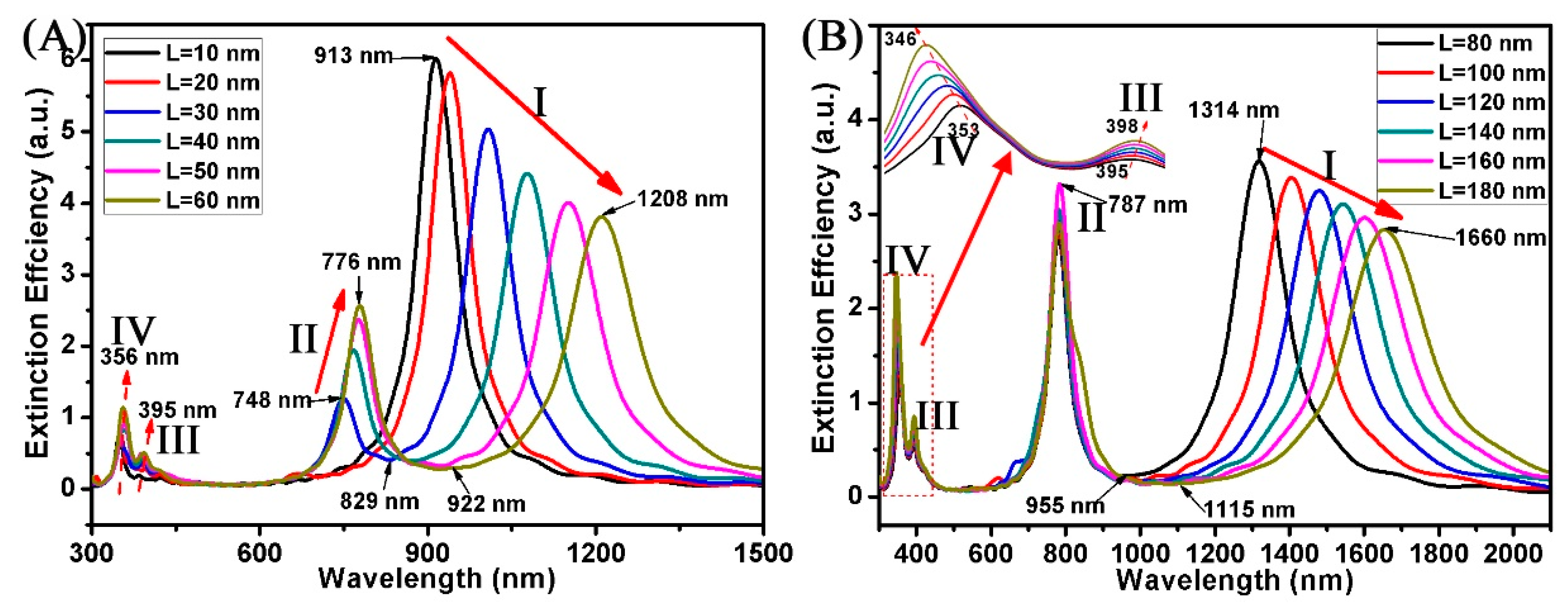
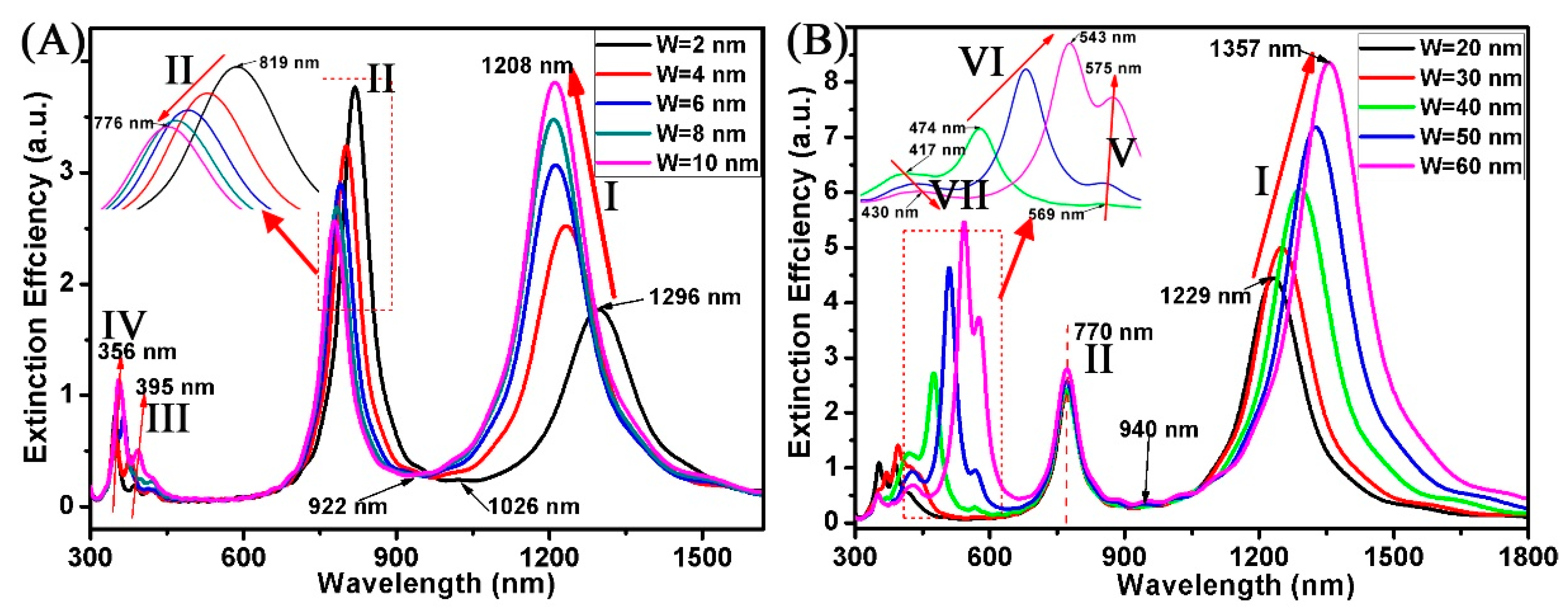
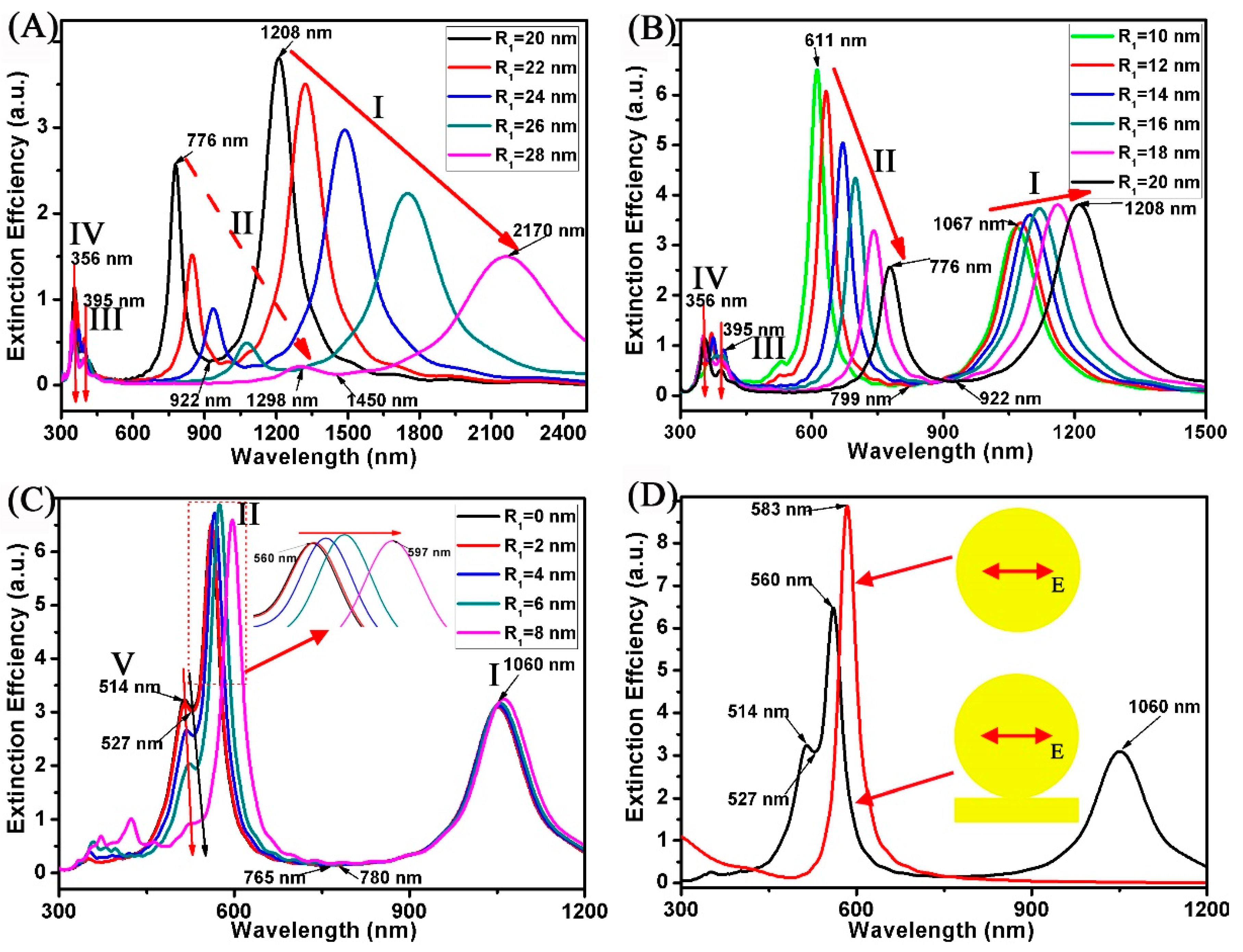
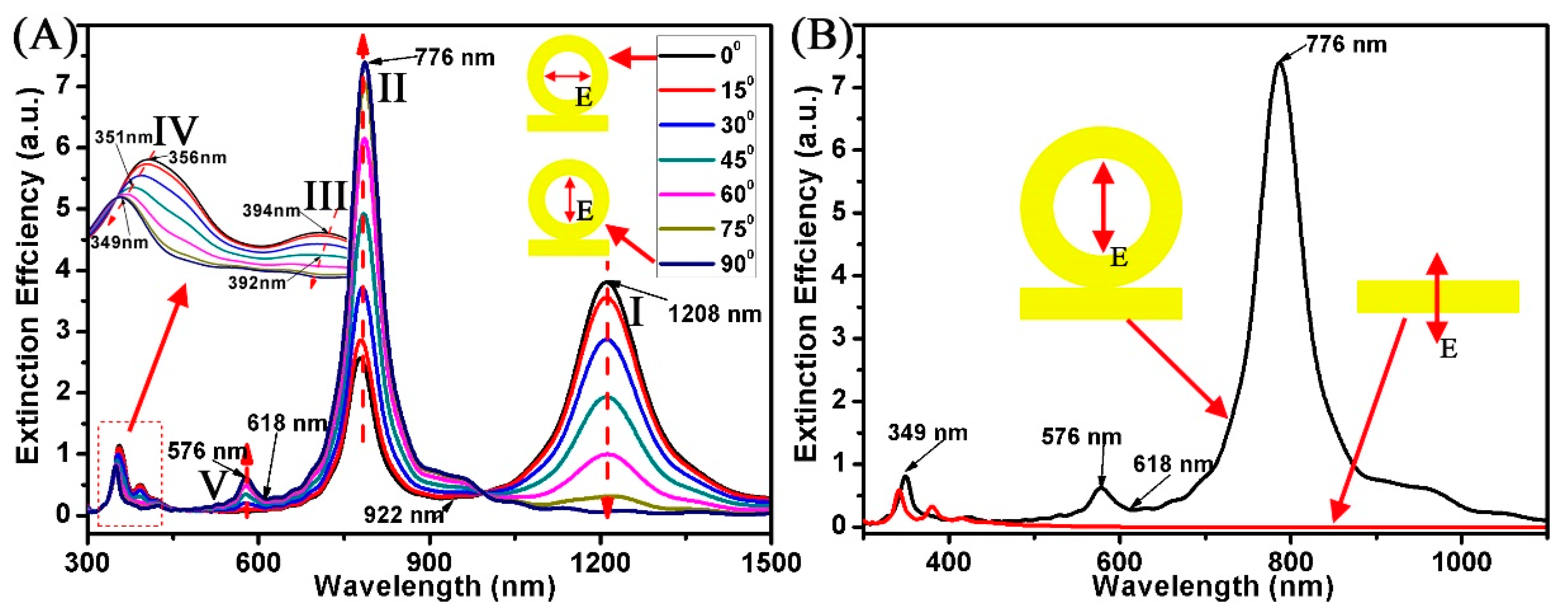
© 2018 by the authors. Licensee MDPI, Basel, Switzerland. This article is an open access article distributed under the terms and conditions of the Creative Commons Attribution (CC BY) license (http://creativecommons.org/licenses/by/4.0/).
Share and Cite
Yi, Z.; Li, X.; Xu, X.; Chen, X.; Ye, X.; Yi, Y.; Duan, T.; Tang, Y.; Liu, J.; Yi, Y. Nanostrip-Induced High Tunability Multipolar Fano Resonances in a Au Ring-Strip Nanosystem. Nanomaterials 2018, 8, 568. https://doi.org/10.3390/nano8080568
Yi Z, Li X, Xu X, Chen X, Ye X, Yi Y, Duan T, Tang Y, Liu J, Yi Y. Nanostrip-Induced High Tunability Multipolar Fano Resonances in a Au Ring-Strip Nanosystem. Nanomaterials. 2018; 8(8):568. https://doi.org/10.3390/nano8080568
Chicago/Turabian StyleYi, Zao, Xin Li, Xibin Xu, Xifang Chen, Xin Ye, Yong Yi, Tao Duan, Yongjian Tang, Jiangwei Liu, and Yougen Yi. 2018. "Nanostrip-Induced High Tunability Multipolar Fano Resonances in a Au Ring-Strip Nanosystem" Nanomaterials 8, no. 8: 568. https://doi.org/10.3390/nano8080568
APA StyleYi, Z., Li, X., Xu, X., Chen, X., Ye, X., Yi, Y., Duan, T., Tang, Y., Liu, J., & Yi, Y. (2018). Nanostrip-Induced High Tunability Multipolar Fano Resonances in a Au Ring-Strip Nanosystem. Nanomaterials, 8(8), 568. https://doi.org/10.3390/nano8080568




